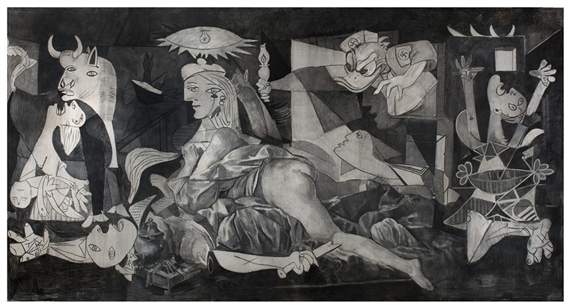Wolfe von Lenkiewicz: Victory Over the Sum
The title of the exhibition references the pivotal Russian avant-garde opera Victory over the Sun (1913), a tribute to the sense of insurmountable ambition at the dawn of a new era. This same soaring spirit resonates in Von Lenkiewicz. Exquisitely rendered with the arsenal of Old Master techniques at his disposal, Von Lenkiewicz's productions range from the intimate to the grand scale of the Renaissance. By contrast, his compositional elements are drawn from a pool of modern and contemporary art historical stars ranging from Balthus, Picasso, Chagall, Malevich, Warhol, Hirst and Koons. Not intending to trivialise his source material, Von Lenkiewicz's skilful form of art-historical fusion liberates new meanings from the originals.
The exhibitionÔÇÖs centrepiece is a full-scale revisiting of PicassoÔÇÖs Guernica (1937), incorporating imagery from the Oscar-winning Der Fuehrer's Face a work of anti-Nazi propaganda by Walt Disney Studios. Other forceful intrusions include a portrait of Marie-Th├®r├¿se Walter (PicassoÔÇÖs mistress) quarreling with Dora Maar in front of the in-progress masterpiece, combined with a frivolous nude by Francois Boucher. The work is intended as a pictorial probe posing a visual question: how might the meaning of historical events evolve through images? Can one revisit such events without hubris and why insist on doing so?
Throughout the rest of the exhibition, high and low art; world and private history; myth and reality engage in a fraternal dialogue. BrueghelÔÇÖs Tower of Babel (1563) a symbol of universal human language, morphs into the populist spires of Walt DisneyÔÇÖs castle. In another piece, the virginal Snow White is assailed by Schongauer's 15th century demons. Elsewhere, she appears as a sexually charged, adolescent proto-Lolita by Balthus. Perhaps even more strangely, BoccioniÔÇÖs strident sculpture Unique Forms of Continuity in Space (1913) is fused with moon-walking Michael Jackson and Bubbles by way of Jeff KoonÔÇÖs eponymous sculpture. The carnival of pictorial propositions is overwhelming but seem uncannily plausible.
Von LenkiewiczÔÇÖs exhibition follows TriumphÔÇÖs presentations of Tim Noble and Sue Webster, Jake and Dinos Chapman and Damien Hirst. With the galleryÔÇÖs extension to a second location in the Metropol Hotel ÔÇô right next to Red Square, opposite the Bolshoi ÔÇô what could be more appropriate than Von Lenkiewicz's operatic liberation of the theatre of images and the ongoing performance of history.

Recommended for you
The title of the exhibition references the pivotal Russian avant-garde opera Victory over the Sun (1913), a tribute to the sense of insurmountable ambition at the dawn of a new era. This same soaring spirit resonates in Von Lenkiewicz. Exquisitely rendered with the arsenal of Old Master techniques at his disposal, Von Lenkiewicz's productions range from the intimate to the grand scale of the Renaissance. By contrast, his compositional elements are drawn from a pool of modern and contemporary art historical stars ranging from Balthus, Picasso, Chagall, Malevich, Warhol, Hirst and Koons. Not intending to trivialise his source material, Von Lenkiewicz's skilful form of art-historical fusion liberates new meanings from the originals.
The exhibitionÔÇÖs centrepiece is a full-scale revisiting of PicassoÔÇÖs Guernica (1937), incorporating imagery from the Oscar-winning Der Fuehrer's Face a work of anti-Nazi propaganda by Walt Disney Studios. Other forceful intrusions include a portrait of Marie-Th├®r├¿se Walter (PicassoÔÇÖs mistress) quarreling with Dora Maar in front of the in-progress masterpiece, combined with a frivolous nude by Francois Boucher. The work is intended as a pictorial probe posing a visual question: how might the meaning of historical events evolve through images? Can one revisit such events without hubris and why insist on doing so?
Throughout the rest of the exhibition, high and low art; world and private history; myth and reality engage in a fraternal dialogue. BrueghelÔÇÖs Tower of Babel (1563) a symbol of universal human language, morphs into the populist spires of Walt DisneyÔÇÖs castle. In another piece, the virginal Snow White is assailed by Schongauer's 15th century demons. Elsewhere, she appears as a sexually charged, adolescent proto-Lolita by Balthus. Perhaps even more strangely, BoccioniÔÇÖs strident sculpture Unique Forms of Continuity in Space (1913) is fused with moon-walking Michael Jackson and Bubbles by way of Jeff KoonÔÇÖs eponymous sculpture. The carnival of pictorial propositions is overwhelming but seem uncannily plausible.
Von LenkiewiczÔÇÖs exhibition follows TriumphÔÇÖs presentations of Tim Noble and Sue Webster, Jake and Dinos Chapman and Damien Hirst. With the galleryÔÇÖs extension to a second location in the Metropol Hotel ÔÇô right next to Red Square, opposite the Bolshoi ÔÇô what could be more appropriate than Von Lenkiewicz's operatic liberation of the theatre of images and the ongoing performance of history.

 ARTISTS
ARTISTS












